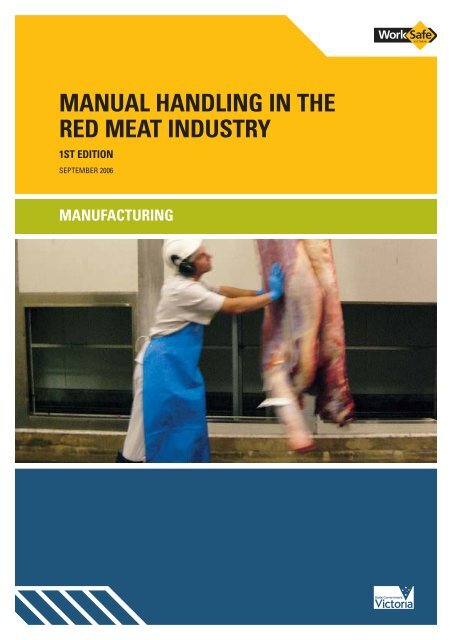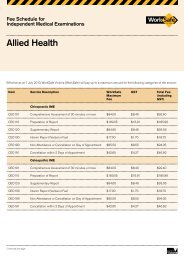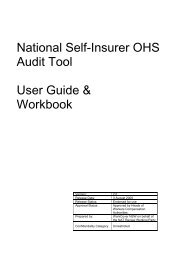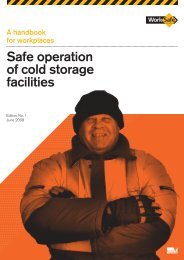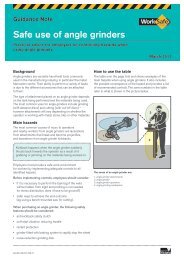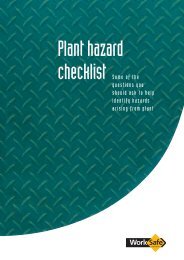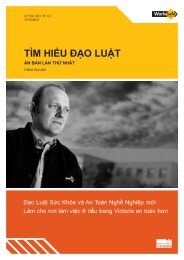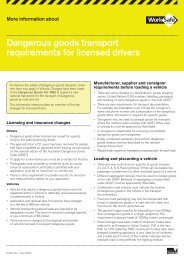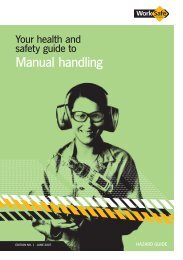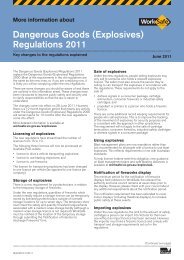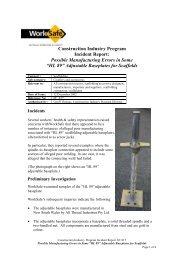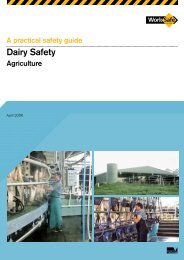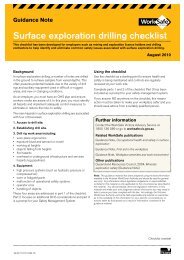Manual Handling In The Red Meat Industry (PDF ... - WorkSafe Victoria
Manual Handling In The Red Meat Industry (PDF ... - WorkSafe Victoria
Manual Handling In The Red Meat Industry (PDF ... - WorkSafe Victoria
Create successful ePaper yourself
Turn your PDF publications into a flip-book with our unique Google optimized e-Paper software.
MANUAL HANDLING IN THE<br />
RED MEAT INDUSTRY<br />
1ST EDITION<br />
SEPTEMBER 2006<br />
MANUFACTURING
CONTENTS<br />
Foreword . . . . . . . . . . . . . . . . . . . . . . . . . . . . . . . . . . . . . . 1<br />
<strong>In</strong>troduction . . . . . . . . . . . . . . . . . . . . . . . . . . . . . . . . . . . . 2<br />
<strong>Manual</strong> handling and musculoskeletal disorders. . . . . . 2<br />
<strong>The</strong> legal framework . . . . . . . . . . . . . . . . . . . . . . . . . . . . 3<br />
<strong>The</strong> OHS (<strong>Manual</strong> <strong>Handling</strong>) Regulations 1999 . . . . . . . 3<br />
Consultation . . . . . . . . . . . . . . . . . . . . . . . . . . . . . . . . . . . . 5<br />
How to use this guide . . . . . . . . . . . . . . . . . . . . . . . . . . . . 6<br />
Reasonably practicable control measures . . . . . . . . . . . . 8<br />
Tasks . . . . . . . . . . . . . . . . . . . . . . . . . . . . . . . . . . . . . . . . . 9<br />
1. Head removal. . . . . . . . . . . . . . . . . . . . . . . . . . . . . . 10<br />
2. Pelting – mutton . . . . . . . . . . . . . . . . . . . . . . . . . . . 12<br />
3. <strong>Handling</strong> tubs of product such as offal or off-cuts. . 13<br />
4. Chiller loading and pushing sides of product . . . . . 16<br />
5. Boning . . . . . . . . . . . . . . . . . . . . . . . . . . . . . . . . . . . 17<br />
6. Further processing such as wrapping<br />
and packing . . . . . . . . . . . . . . . . . . . . . . . . . . . . . . . 19<br />
7. Removing product from large stillages<br />
or containers . . . . . . . . . . . . . . . . . . . . . . . . . . . . . . 21<br />
8. Loading and unloading freezer frames . . . . . . . . . . 22<br />
9. Palletising product . . . . . . . . . . . . . . . . . . . . . . . . . . 24<br />
10. Stretch-wrapping pallets . . . . . . . . . . . . . . . . . . . . . 26<br />
11. <strong>Handling</strong> boxed meat inside trucks and<br />
shipping containers . . . . . . . . . . . . . . . . . . . . . . . . . 27<br />
12. <strong>Handling</strong> empty pallets . . . . . . . . . . . . . . . . . . . . . . 28<br />
13. Load out and lumping . . . . . . . . . . . . . . . . . . . . . . . 29<br />
Plant and other hazards. . . . . . . . . . . . . . . . . . . . . . . . . . 31<br />
<strong>In</strong>formation for employers. . . . . . . . . . . . . . . . . . . . . . . . 32<br />
Other useful guidance material. . . . . . . . . . . . . . . . . . . . 33<br />
Acknowledgements . . . . . . . . . . . . . . . . . . . . . . . . . . . . 34<br />
<strong>The</strong> information presented in <strong>Manual</strong> <strong>Handling</strong> in the <strong>Red</strong> <strong>Meat</strong> <strong>In</strong>dustry is intended<br />
for general use only. It should not be viewed as a definitive guide to the law, and<br />
should be read in conjunction with the Occupational Health and Safety Act 2004.<br />
While every effort has been made to ensure the accuracy of this guide, the advice<br />
contained herein may not apply in every circumstance. Accordingly, the <strong>Victoria</strong>n<br />
WorkCover Authority cannot be held responsible, and extends no warranties as to:<br />
• the suitability of the information for any particular purpose;<br />
• actions taken by third parties as a result of the information contained in <strong>Manual</strong><br />
<strong>Handling</strong> in the <strong>Red</strong> <strong>Meat</strong> <strong>In</strong>dustry.<br />
<strong>The</strong> information contained in <strong>Manual</strong> <strong>Handling</strong> in the <strong>Red</strong> <strong>Meat</strong> <strong>In</strong>dustry is protected<br />
by copyright. <strong>The</strong> <strong>Victoria</strong>n WorkCover Authority hereby grants a non-exclusive licence<br />
in this publication to the recipient of this publication on the condition that it is not<br />
disseminated for profit. <strong>The</strong> <strong>Victoria</strong>n WorkCover Authority encourages the free<br />
transfer, copying and printing of the information in this publication if such activities<br />
support the purposes and intent for which the publication was developed.<br />
<strong>WorkSafe</strong> <strong>Victoria</strong> is a division of the <strong>Victoria</strong>n WorkCover Authority.
FOREWORD<br />
<strong>The</strong> red meat processing industry comprises both abattoirs for beef, mutton and<br />
pork as well as smallgoods manufacturers and rendering plants.<br />
A significant contributor to the <strong>Victoria</strong>n economy, the industry has an annual<br />
turnover in excess of $890 million.<br />
<strong>WorkSafe</strong> <strong>Victoria</strong> has developed this publication – detailing some common manual<br />
handling tasks carried out in the industry – to help reduce the risk of injury.<br />
<strong>Manual</strong> handling is the primary cause of musculoskeletal disorders (MSD),<br />
such as muscle strains and injuries to ligaments and other structures in the back<br />
and upper limbs, accounting for more than half of all injuries in the red meat<br />
processing industry.<br />
This publication provides practical guidance on a range of risk control solutions<br />
currently used at workplaces in <strong>Victoria</strong>. <strong>WorkSafe</strong> encourages everyone involved<br />
in the red meat processing industry to read this publication and take action to<br />
implement solutions to control risk wherever reasonably practicable.<br />
<strong>WorkSafe</strong> would like to acknowledge and thank the employers, employees,<br />
industry associations, unions, ergonomists, and health and safety representatives<br />
involved in the development of this publication.<br />
WORKSAFE VICTORIA / MANUAL HANDLING IN THE RED MEAT INDUSTRY 1
INTRODUCTION<br />
This guide demonstrates <strong>WorkSafe</strong>’s expectations on how to best reduce the risk<br />
of MSD arising from manual handling in the red meat industry. Many risk controls<br />
outlined here have been implemented in the red meat industry in <strong>Victoria</strong>.<br />
MANUAL HANDLING<br />
<strong>In</strong> the red meat industry, manual handling covers a wide range of activities such<br />
as slaughtering, boning, smallgoods manufacturing, rendering, retail butchering,<br />
wrapping and packing. Undertaking these tasks incorrectly can result in<br />
musculoskeletal disorders and other types of injuries. However, not all manual<br />
handling is hazardous.<br />
Hazardous manual handling refers to actions with any of the following<br />
characteristics:<br />
• Repetitive or sustained application of force.<br />
• Repetitive or sustained awkward posture.<br />
• Repetitive or sustained movement.<br />
• Application of high force.<br />
• Exposure to sustained vibration.<br />
• <strong>Manual</strong> handling of live persons or animals.<br />
• Unstable or unbalanced loads or loads which are difficult to grasp or hold.<br />
MUSCULOSKELETAL DISORDERS<br />
MSD are sometimes referred to as ‘sprains and strains’ and describe injuries and<br />
diseases of the musculoskeletal system.<br />
This includes injuries to joints, ligaments, intervertebral discs and other structures<br />
in the back, as well as injuries to joints, ligaments, tendons, muscles and nerves in<br />
the wrists, elbows, arms, shoulders, neck, abdomen (eg. hernia), hips, knees and<br />
legs. Some of these conditions can be described as repetitive strain injury (RSI),<br />
occupational overuse syndrome (OOS), cumulative trauma disorder (CTD) and<br />
work-related musculoskeletal disorder (WRMSD).<br />
<strong>In</strong> the Occupational Health and Safety (<strong>Manual</strong> <strong>Handling</strong>) Regulations 1999<br />
(<strong>Manual</strong> <strong>Handling</strong> Regulations), all of these conditions are referred to as<br />
musculoskeletal disorders (MSD).<br />
2 WORKSAFE VICTORIA / MANUAL HANDLING IN THE RED MEAT INDUSTRY
INTRODUCTION<br />
THE LEGAL FRAMEWORK<br />
<strong>The</strong>re is a legislative framework around controlling risk and consultation in the<br />
workplace. This guide shows ways to comply, primarily with the Occupational<br />
Health and Safety (<strong>Manual</strong> <strong>Handling</strong>) Regulations 1999.<br />
THE OCCUPATIONAL HEALTH AND SAFETY (MANUAL HANDLING)<br />
REGULATIONS 1999<br />
Under these regulations the employer has a duty to:<br />
• identify tasks involving hazardous manual handling;<br />
• assess the risk of developing a musculoskeletal disorder associated with the<br />
task; and<br />
• control the risk by eliminating the risk or reducing it so far as is reasonably<br />
practicable.<br />
GENERAL<br />
• Postures, movements and forces known to be associated with MSD should<br />
be eliminated from the workplace wherever possible.<br />
• Employees should not be required to routinely work above their shoulder<br />
height, below their knees or at full reach distance.<br />
• Physical changes to workplace design, layout and plant are more effective<br />
than administrative risk controls.<br />
• To accommodate different people and tasks, workstations should be easy<br />
to adjust.<br />
GREEN – LOW RISK<br />
AMBER – MEDIUM RISK<br />
RED – HIGH RISK<br />
Hazard identification<br />
This guide identifies some tasks performed within the red meat industry that are<br />
hazardous and have resulted in MSD. This is not a comprehensive list of all<br />
tasks involving hazardous manual handling within the industry.<br />
Risk assessment<br />
This guide follows the risk assessment format used in the <strong>WorkSafe</strong> publication<br />
<strong>Manual</strong> <strong>Handling</strong> (Code of Practice No. 25, 2000).<br />
It helps indicate which risk factors may be in your workplace and, in particular,<br />
demonstrates those that result in high-risk work practices which may put people<br />
at risk of developing MSD.<br />
<strong>The</strong> guide cannot replace the requirement for risk assessment and risk control,<br />
as the risk of developing MSD will vary depending on the circumstances in each<br />
workplace. To ensure a reduction in MSD, employers should review risks and<br />
develop and implement a plan for controls in consultation with employees.<br />
WORKSAFE VICTORIA / MANUAL HANDLING IN THE RED MEAT INDUSTRY 3
INTRODUCTION<br />
Risk control<br />
Risk controls are shown in the guide. Under the <strong>Manual</strong> <strong>Handling</strong> Regulations<br />
it is the duty of an employer to carry out risk controls including:<br />
1. eliminating the risk (eg. redesign so as to eliminate handling); or<br />
2. if it is not practicable to eliminate the risk, reduce the risk so far as is reasonably<br />
practicable.<br />
<strong>In</strong> either case, the risk can be controlled in any of the following ways:<br />
a. altering the workplace or environmental conditions (eg. using conveyors).<br />
b. altering the systems of work (eg. adjusting work rates, regular maintenance<br />
on equipment, job rotation, etc.).<br />
c. changing the objects (eg. breaking down a carcass to reduce weight).<br />
d. using mechanical aids (eg. pallet lifters, height adjustable trolleys or forklift<br />
attachments).<br />
A combination of controls often gives the best solution.<br />
Consult health and safety representatives (HSRs) and employees and trial<br />
proposed solutions to determine if they are right for your workplace or if<br />
further modifications or different controls are needed. Once the controls are<br />
in place, they should be monitored to assess their suitability and success.<br />
Providing information, training and instructions in manual handling techniques are<br />
not suitable ways of controlling risk, unless all other ways to control risk are not<br />
practicable.<br />
When such training is provided, it must be task-specific and competency-based to<br />
be effective. Supervisors must be competent in undertaking manual tasks and be<br />
supported in this role. <strong>The</strong>re should be appropriate supervision of safety as well as<br />
production.<br />
You should always check the legislation referred to in this material and make your<br />
own judgement about what action you may need to take to ensure you have<br />
complied with the law.<br />
Note: This guide should be read together with the Occupational Health and Safety<br />
(<strong>Manual</strong> <strong>Handling</strong>) Regulations 1999 and the <strong>WorkSafe</strong> publication <strong>Manual</strong><br />
<strong>Handling</strong> (Code of Practice No. 25, 2000). On 1July 2007 new consolidated<br />
regulations will come into effect, replacing current manual handling regulations.<br />
4 WORKSAFE VICTORIA / MANUAL HANDLING IN THE RED MEAT INDUSTRY
CONSULTATION<br />
Since 1 January 2006, all employers are required to consult employees, so far<br />
as is reasonably practicable, on matters that may directly affect employees’ health,<br />
safety or welfare. This includes consultation with an independent contractor and<br />
any employees of the independent contractor.<br />
Where there are elected HSRs, the employer must consult with them to identify<br />
hazards and assess risks and risk control, as well as consulting on any proposed<br />
changes in the workplace, plant, substances or work processes that could impact<br />
on the health, safety or welfare of the employees.<br />
<strong>The</strong> duty to consult recognises that employee input and participation improves<br />
decision-making about health and safety matters. Consultation between employers<br />
and employees is vital in effectively managing health and safety at work and<br />
should be viewed as a legal requirement and as a valuable means of improving<br />
health and safety outcomes.<br />
By consulting, employers can become more aware of hazards and OHS issues of<br />
concern to employees who can also provide suggestions about how to solve OHS<br />
problems. Participation enables employees to play a role in determining how work<br />
can be done safely.<br />
For more information on the duty to consult, please refer to the <strong>WorkSafe</strong> Guide<br />
Talking Safety Together and Consultation – A User’s Guide. <strong>In</strong>formation for<br />
Employees on Health and Safety and <strong>In</strong>formation for Health and Safety<br />
Representatives also contain information for employees and HSRs.<br />
WORKSAFE VICTORIA / MANUAL HANDLING IN THE RED MEAT INDUSTRY 5
HOW TO USE<br />
THIS GUIDE<br />
<strong>The</strong> red, amber and green or ‘traffic light’ format will help you to identify high-risk<br />
activities and assess your workplace to implement safer work practices. <strong>The</strong><br />
rationale is simple: to reduce injury rates and compensation claims, high-risk<br />
situations must be addressed.<br />
<strong>The</strong> red, or high-risk, column is split into two sections. One is for actions<br />
(postures, movements or forces) that may give rise to the risk of MSD. <strong>The</strong> other<br />
is for potential sources of that risk.<br />
A better understanding of what causes the risk of MSD will result in better risk<br />
control. Potential sources of the risk are also listed, although your workplace may<br />
discover other reasons why those actions are being undertaken and should control<br />
these accordingly.<br />
If high-risk practices are followed in your workplace, you should determine if you<br />
can use the green solutions. If this isn’t practicable, put in place a comparable<br />
amber practice as a reduced-risk solution.<br />
<strong>In</strong> the amber and green columns, the solutions listed first are preferred and will<br />
generally be more effective than solutions towards the bottom of the column.<br />
<strong>The</strong> amber and green manual handling solution sections in this guide provide some<br />
different options because the tasks, and the risks, vary according to the specifics<br />
at your workplace. It is important to ensure any controls you implement address<br />
the risk factors in the task.<br />
RED (HIGH RISK) AMBER SOLUTION GREEN SOLUTION<br />
<strong>The</strong> practices in the red<br />
column should not be<br />
used in workplaces;<br />
an employer who allows<br />
these practices to be<br />
used is likely to be<br />
in breach of OHS<br />
legislation.<br />
<strong>The</strong> solutions in the<br />
amber column are less<br />
effective in reducing risk<br />
than those in the green<br />
column, and should be<br />
regularly reviewed with<br />
the aim to move towards<br />
higher order solutions<br />
(green).<br />
<strong>The</strong> solutions in the<br />
green column are the<br />
most effective at<br />
reducing risk and should<br />
be regarded as the target<br />
for all workplaces.<br />
6 WORKSAFE VICTORIA / MANUAL HANDLING IN THE RED MEAT INDUSTRY
HOW TO USE THIS GUIDE<br />
<strong>Red</strong>, high risk, column<br />
Solutions should<br />
continue to be<br />
reviewed as higher<br />
order controls<br />
become more<br />
practicable<br />
Are any solutions<br />
from the green column<br />
reasonably practicable<br />
for the workplace<br />
(Undertake<br />
practicability test)<br />
NO<br />
Implement solutions<br />
from the amber,<br />
reduced-risk, column<br />
YES<br />
Implement a solution<br />
from the green,<br />
preferred solution,<br />
column<br />
Note: If you are able to demonstrate that an appropriate risk assessment process<br />
has been undertaken and you are able to verify that the reasonably practicable test<br />
has been applied to the controls you implement, then amber control measures<br />
may be practicable in some circumstances.<br />
WORKSAFE VICTORIA / MANUAL HANDLING IN THE RED MEAT INDUSTRY 7
REASONABLY<br />
PRACTICABLE<br />
CONTROL MEASURES<br />
<strong>The</strong> Occupational Health and Safety Act 2004 explains what must be taken into<br />
account when determining if something is ‘reasonably practicable’. <strong>In</strong> general<br />
terms, these factors are:<br />
• <strong>The</strong> likelihood of the hazard or risk eventuating.<br />
• <strong>The</strong> degree of harm that would result if the hazard or risk eventuated.<br />
• What you know, or ought reasonably to know, about the hazard or risk and any<br />
ways of eliminating or reducing the hazard or risk.<br />
• <strong>The</strong> availability and suitability of ways to eliminate or reduce the hazard or risk.<br />
• <strong>The</strong> cost of eliminating or reducing the hazard or risk.<br />
This guide should assist in identifying what you know or should reasonably know<br />
and what you should reasonably do. It is expected that employers, employees and<br />
<strong>WorkSafe</strong> inspectors will use it to form an opinion about suitable health and safety<br />
risk controls under the ‘reasonably practicable’ test.<br />
8 WORKSAFE VICTORIA / MANUAL HANDLING IN THE RED MEAT INDUSTRY
TASKS<br />
1<br />
1. Head removal. . . . . . . . . . . . . . . . . . . . . . . . . . . . . . . . . . . . . . . . . 10<br />
2. Pelting – mutton. . . . . . . . . . . . . . . . . . . . . . . . . . . . . . . . . . . . . . . 12<br />
3. <strong>Handling</strong> tubs of product such as offal or off-cuts . . . . . . . . . . . . . 13<br />
4. Chiller loading and pushing sides of product . . . . . . . . . . . . . . . . 16<br />
5. Boning . . . . . . . . . . . . . . . . . . . . . . . . . . . . . . . . . . . . . . . . . . . . . . 17<br />
6. Further processing such as wrapping and packing . . . . . . . . . . . 19<br />
7. Removing product from large stillages or containers . . . . . . . . . 21<br />
8. Loading and unloading freezer frames . . . . . . . . . . . . . . . . . . . . . 22<br />
9. Palletising product . . . . . . . . . . . . . . . . . . . . . . . . . . . . . . . . . . . . . 24<br />
10. Stretch-wrapping pallets . . . . . . . . . . . . . . . . . . . . . . . . . . . . . . . . 26<br />
11. <strong>Handling</strong> boxed meat inside trucks and<br />
shipping containers . . . . . . . . . . . . . . . . . . . . . . . . . . . . . . . . . . . . 27<br />
12. <strong>Handling</strong> empty pallets . . . . . . . . . . . . . . . . . . . . . . . . . . . . . . . . . 28<br />
13. Load out and lumping . . . . . . . . . . . . . . . . . . . . . . . . . . . . . . . . . . 29<br />
WORKSAFE VICTORIA / MANUAL HANDLING IN THE RED MEAT INDUSTRY 9
1. HEAD REMOVAL<br />
Head removal of beef involves high force, often with the arms outstretched,<br />
increasing the horizontal distance to the lower back when trying to catch or<br />
hold the heavy load.<br />
<strong>The</strong> head is then transferred to another rail and this can involve twisting of<br />
the back.<br />
Image supplied by <strong>Meat</strong> & Livestock Australia<br />
HIGH RISK REDUCED-RISK SOLUTION LOW RISK<br />
ACTION<br />
High force<br />
Lifting, lowering or<br />
carrying heavy loads.<br />
Catching, holding or<br />
supporting a heavy<br />
object.<br />
Exerting force with<br />
the non-preferred<br />
hand.<br />
Exerting high force<br />
while in an awkward<br />
posture.<br />
POTENTIAL SOURCE<br />
OF RISK<br />
Standing position<br />
means the employee<br />
has to reach away<br />
from the body, above<br />
shoulder height or<br />
below mid-thigh<br />
height to sever,<br />
support and re-hang<br />
the head.<br />
<strong>The</strong> position of the<br />
head rail is distant to<br />
the main rail.<br />
<strong>The</strong> weight and size<br />
of the head.<br />
Wearing gloves and<br />
handling a slippery<br />
object.<br />
Provide mechanical aids to<br />
support the weight of the head if<br />
there is enough room to safely<br />
manoeuvre the aid.<br />
<strong>The</strong> above height adjustable trolley<br />
is used to support the head after it<br />
is removed and to transport it to the<br />
production area for tongue/cheek<br />
removal. <strong>The</strong> trolley must always be<br />
sanitised.<br />
Implement engineering controls.<br />
Image supplied by <strong>Meat</strong> & Livestock Australia<br />
With the main chain and head chain<br />
running parallel, the torso and head are<br />
separated and the hook bears the load.<br />
This is another example of a head rail<br />
and hook used to support the weight<br />
of the head once it has been severed.<br />
<strong>The</strong> lifter is positioned close to the<br />
carcass, with a hook attached before<br />
the head is severed, ensuring the<br />
employee doesn’t need to catch and<br />
support the head.<br />
<strong>The</strong> section of the rail shown is<br />
automatically raised to allow further<br />
processing of the head.<br />
10 WORKSAFE VICTORIA / MANUAL HANDLING IN THE RED MEAT INDUSTRY
1. HEAD REMOVAL CONTINUED<br />
HIGH RISK REDUCED-RISK SOLUTION LOW RISK<br />
ACTION<br />
POTENTIAL SOURCE<br />
OF RISK<br />
For small stock a mechanical aid can<br />
be used to sever the head without any<br />
manual handling.<br />
WORKSAFE VICTORIA / MANUAL HANDLING IN THE RED MEAT INDUSTRY 11
2. PELTING – MUTTON<br />
Pelting mutton is a staged process largely controlled by mechanical hide pullers.<br />
Where parts of these tasks are performed manually, this ‘punching’ down involves<br />
repetitive awkward postures, high forces, grabbing, pulling and other movements<br />
that can result in MSD.<br />
Image supplied by <strong>Meat</strong> & Livestock Australia<br />
HIGH RISK REDUCED-RISK SOLUTION LOW RISK<br />
ACTION<br />
Bending the back<br />
forwards more than<br />
20 degrees, twisting<br />
the back more than<br />
20 degrees, exerting<br />
force while in an<br />
awkward posture:<br />
POTENTIAL SOURCE<br />
OF RISK<br />
<strong>The</strong> nature of the<br />
load.<br />
<strong>The</strong> height of the<br />
task.<br />
Use rails to present task at<br />
heights that reduce the need to<br />
bend and reach.<br />
Use mechanical hide pullers.<br />
• > twice per minute<br />
• with long duration<br />
(> 30 minutes<br />
continuously or<br />
> 2 hours over the<br />
whole shift).<br />
<strong>The</strong>se actions may<br />
occur in the situations<br />
listed under ‘potential<br />
source of risk’ or in<br />
combination with<br />
other work activities.<br />
Training in the use of mechanical aids<br />
such as pelting arms to assist with<br />
the task.<br />
A mechanical hide puller is used to<br />
eliminate the manual handling in this<br />
part of the task.<br />
High force<br />
Exerting high force<br />
while in an awkward<br />
posture.<br />
12 WORKSAFE VICTORIA / MANUAL HANDLING IN THE RED MEAT INDUSTRY
3. HANDLING TUBS OF PRODUCT<br />
SUCH AS OFFAL OR OFF-CUTS<br />
Pushing and pulling tubs of product at ground level requires employees to forward<br />
bend their backs and exert force in awkward postures. <strong>The</strong> force required to push<br />
and pull trolleys or bins can be influenced by the floor surface and the size of the<br />
trolley wheels, as well as by other variables.<br />
<strong>Handling</strong> tubs of product over wet floor surfaces introduces the added risks of<br />
slipping and falling which can also result in MSD.<br />
HIGH RISK REDUCED-RISK SOLUTION LOW RISK<br />
ACTION<br />
High force<br />
Exerting force while in<br />
an awkward posture.<br />
Pushing and pulling<br />
objects that are hard<br />
to move or stop.<br />
POTENTIAL SOURCE<br />
OF RISK<br />
Position of the tub at<br />
ground level.<br />
<strong>The</strong> weight of the<br />
tubs or trolley.<br />
Slippery floor or<br />
surface.<br />
Use mechanical aids such as<br />
trolleys to keep loads at heights<br />
that eliminate or reduce the need<br />
to bend.<br />
Where practicable, eliminate<br />
hazardous manual handling by<br />
using floor chutes and conveyors.<br />
A purpose built trolley bin in the<br />
photo above is used to collect viscera<br />
(gut content).<br />
For employees working on an<br />
evisceration conveyor, the conveyor<br />
transfers the gut contents eliminating<br />
the need for handling trolleys or tubs.<br />
Use a mechanical aid to raise and<br />
tip offal bins.<br />
Tipping the heavy offal bin above is<br />
made easier with handles on the bin<br />
and the receptacle below floor height<br />
eliminating the need to lift. Edge<br />
protection would be required for a<br />
drop greater than two metres.<br />
A trolley bin elevator and tipper handles<br />
viscera from the kill floor.<br />
WORKSAFE VICTORIA / MANUAL HANDLING IN THE RED MEAT INDUSTRY 13
3. HANDLING TUBS OF PRODUCT<br />
SUCH AS OFFAL OR OFF-CUTS CONTINUED<br />
HIGH RISK REDUCED-RISK SOLUTION LOW RISK<br />
ACTION<br />
POTENTIAL SOURCE<br />
OF RISK<br />
Use a system to collect off-cuts<br />
from the hanging carcass and a<br />
trolley to transfer the off-cuts for<br />
further processing.<br />
Use floor chutes to reduce the carrying<br />
distance when disposing of tubs of<br />
waste from the kill floor.<br />
<strong>The</strong> trough collects off-cuts and is<br />
sloped to help transfer the off-cuts to<br />
a transfer trolley.<br />
<strong>In</strong> one workplace, well-placed floor<br />
chutes in the boning area<br />
eliminated the double-handling<br />
previously needed to place scraps<br />
into tubs before being dropped<br />
into chutes.<br />
A well-designed trolley is used to raise<br />
the height of the white tub.<br />
<strong>Red</strong>uce the amounts carried in<br />
the tub or container to reduce the<br />
force required to move the load.<br />
Improve trolley design by<br />
changing the diameter of the<br />
wheels (see table on trolleys over<br />
the page).<br />
14 WORKSAFE VICTORIA / MANUAL HANDLING IN THE RED MEAT INDUSTRY
3. HANDLING TUBS OF PRODUCT<br />
SUCH AS OFFAL OR OFF-CUTS CONTINUED<br />
Trolley information<br />
Trolley design.<br />
Castor choice.<br />
Floor surfaces.<br />
Housekeeping.<br />
Maintenance.<br />
POTENTIAL HAZARD SOURCE<br />
Poor trolley design results in a high<br />
centre of gravity so that pushing it<br />
over uneven surfaces may tip the<br />
trolley.<br />
No handles or handles placed too<br />
low so that force is applied in<br />
awkward postures.<br />
<strong>In</strong>sufficient number of trolleys<br />
resulting in over stacking those<br />
that are available:<br />
• stacking too high affects<br />
visibility with the user needing<br />
to adopt an awkward posture to<br />
see around the load<br />
• exceeding load rating.<br />
Flat tyres or flat spots make<br />
trolleys difficult to get moving<br />
when being manually pushed or<br />
pulled.<br />
Small diameter castors.<br />
Cracks and uneven or non smooth<br />
floors can make trolleys harder to<br />
move by increasing the pushing<br />
forces.<br />
Steep gradients on ramps increase<br />
the force needed to move trolleys.<br />
Wet floors create the risk of<br />
slipping.<br />
Slippery floors due to blood, fats,<br />
etc. make it harder to move<br />
trolleys.<br />
Damaged trolleys and castors<br />
make it harder to move trolleys.<br />
RISK CONTROL<br />
A height adjustable spring or<br />
scissor trolley will allow loading at<br />
a good height and provide a low<br />
centre of gravity for stability when<br />
pushing.<br />
Place heavier items at the base to<br />
reduce the centre of gravity.<br />
Good handles provided, eg. vertical<br />
handles will fit a large range of<br />
users.<br />
Sufficient number of trolleys also<br />
allows for appropriate maintenance<br />
to be carried out.<br />
Limit height at which trolleys can<br />
be stacked.<br />
Have load rating marked on trolley.<br />
Solid tyres or ones with adequate<br />
tyre pressure.<br />
Large diameter castors.<br />
Low resistance bearings.<br />
<strong>In</strong>spect and regularly maintain floor<br />
surfaces to ensure they are kept<br />
clean, smooth and well looked<br />
after.<br />
Ensure trolleys are handled on flat<br />
or low gradient surfaces.<br />
Ensure floor surfaces are suitable<br />
for wet areas.<br />
Regularly clean work areas to keep<br />
them clean and free of slip and fall<br />
hazards as much as is practicable.<br />
Immediately remove and repair or<br />
replace any damaged trolleys.<br />
Implement a systematic<br />
prevention maintenance system<br />
for trolleys and castors.<br />
• <strong>The</strong> Ergonomics of <strong>Manual</strong> Material <strong>Handling</strong> – pushing and pulling tasks is a<br />
useful reference on pushing trolleys and is known as the Darcor and Ergoweb<br />
white paper on trolleys. See http://www.darcor.com/library_wp.htm.<br />
WORKSAFE VICTORIA / MANUAL HANDLING IN THE RED MEAT INDUSTRY 15
4. CHILLER LOADING AND<br />
PUSHING SIDES OF PRODUCT<br />
Pushing carcasses requires high force exertion in awkward postures and usually<br />
in environments where temperatures are too cold for prolonged manual handling<br />
activity if the employee is not wearing additional layers of clothing.<br />
Often there is also the risk of falls, with blood and ice making the floor slippery.<br />
High push forces and the lack of slip resistance increases the likelihood of this<br />
risk, even for the strongest employee.<br />
HIGH RISK REDUCED-RISK SOLUTION LOW RISK<br />
ACTION<br />
High force<br />
Exerting force while in<br />
an awkward posture.<br />
Pushing and pulling<br />
objects that are hard<br />
to move or stop.<br />
POTENTIAL SOURCE<br />
OF RISK<br />
Weight of carcasses.<br />
Condition or<br />
maintenance of<br />
overhead rails.<br />
Maintain overhead rail systems<br />
and hooks.<br />
Establish a set limit on the<br />
maximum number of sides in<br />
the workplace to be handled<br />
by employees at a time. Train<br />
employees on this and ensure<br />
it is enforced.<br />
Where possible, install gravity<br />
rails (at very small gradients). It is<br />
important and necessary to assess<br />
the risks associated with a moving<br />
carcass striking someone.<br />
Use low resistance hooks<br />
(product dependent) to reduce<br />
push forces.<br />
A limit of two sides of one carcass<br />
enables a push without excessive force.<br />
Low resistance plastic hooks used with<br />
mutton.<br />
16 WORKSAFE VICTORIA / MANUAL HANDLING IN THE RED MEAT INDUSTRY
5. BONING<br />
Boning is associated with a high rate of MSD – particularly of the wrist and arms.<br />
Though highly skilled work, it is very repetitive and can require the application<br />
of high force, particularly if the knife has become blunt or if meat contains hard<br />
fat or is at a low temperature.<br />
HIGH RISK REDUCED-RISK SOLUTION LOW RISK<br />
ACTION<br />
Bending the back<br />
forwards more than<br />
20 degrees, and<br />
exerting force while in<br />
an awkward posture:<br />
• > twice per minute<br />
• > 30 seconds at a<br />
time<br />
• with long duration<br />
(> 30 minutes<br />
continuously or<br />
> 2 hours over the<br />
whole shift).<br />
<strong>The</strong>se actions may<br />
occur in situations<br />
listed under ‘potential<br />
source of risk’ or in<br />
combination with<br />
other work activities.<br />
POTENTIAL SOURCE<br />
OF RISK<br />
Boning tables too high<br />
or too low for the<br />
individual.<br />
Height of the cut on<br />
the side chain too high<br />
or too low for the<br />
individual.<br />
<strong>In</strong>stall adjustable workstations.<br />
Provide height adjustable<br />
workstations and train employees<br />
in how to use them.<br />
<strong>Meat</strong> tensioning equipment is one<br />
example of a mechanical aid to<br />
assist the manual handling<br />
involved in boning.<br />
Employers should continually<br />
review all available technologies to<br />
determine if they are reasonably<br />
practicable for the workplace.<br />
Use boning technology that allows<br />
the employee to complete the<br />
work in a comfortable and natural<br />
(upright) posture as much as<br />
possible.<br />
Adjustable stands better match the<br />
different heights of individuals.<br />
<strong>The</strong> employee is able to work close<br />
to his body, with an upright posture,<br />
where the cutting/boning is done mainly<br />
between the waist and shoulder height.<br />
A simple mechanism to alter heights.<br />
WORKSAFE VICTORIA / MANUAL HANDLING IN THE RED MEAT INDUSTRY 17
5. BONING CONTINUED<br />
HIGH RISK REDUCED-RISK SOLUTION LOW RISK<br />
ACTION<br />
POTENTIAL SOURCE<br />
OF RISK<br />
Platforms are used to raise the height<br />
of the employees for the various stages<br />
of the cut on this side chain.<br />
This technology also pulls the meat<br />
away from the bone, allowing more<br />
natural back and shoulder postures.<br />
Excessive bending of<br />
the wrist, exerting<br />
force with one hand,<br />
twisting and turning<br />
actions with the hands<br />
and arms and<br />
sustained holding of a<br />
tool – knife and/or<br />
meat hook:<br />
• > twice per minute<br />
• > 30 seconds at a<br />
time<br />
• with long duration<br />
(> 30 minutes<br />
continuously or<br />
> 2 hours over the<br />
whole shift).<br />
<strong>The</strong>se actions may<br />
occur in situations<br />
listed under ‘potential<br />
source of risk’ or in<br />
combination with<br />
other work activities.<br />
Using a knife that is<br />
not sharp enough.<br />
Hard fat.<br />
Chilled carcasses.<br />
Holding hook to pull<br />
meat from bone.<br />
Ensure an effective knife sharpening<br />
program is implemented including<br />
competency-based training in the<br />
selection, use and sharpening of<br />
knives, as far as is reasonably<br />
practicable.<br />
Ensure carcass is at the correct<br />
temperature for boning, especially<br />
after weekends or extended time<br />
periods in chillers.<br />
Together with a sharp knife, use<br />
a mechanical aid such as meat<br />
tensioning equipment.<br />
Use technology that assists in the<br />
boning process.<br />
<strong>Meat</strong> is mechanically pulled away from<br />
the bone, reducing awkward wrist<br />
postures of the cutting hand.<br />
18 WORKSAFE VICTORIA / MANUAL HANDLING IN THE RED MEAT INDUSTRY
6. FURTHER PROCESSING SUCH<br />
AS WRAPPING AND PACKING<br />
When people work for prolonged periods of time at fixed workstations or next<br />
to conveyors, it is vital that each workstation is adjusted for each employee,<br />
maximising productivity and reducing the risk of MSD.<br />
When undertaking this activity, hazardous manual handling indicators include<br />
awkward postures, such as raised shoulders, and repeated actions such as<br />
reaching to pick up cuts of meat or twisting the body while handling loads.<br />
HIGH RISK REDUCED-RISK SOLUTION LOW RISK<br />
ACTION<br />
Exerting force while in<br />
an awkward posture:<br />
• > twice per minute<br />
• > 30 seconds at a<br />
time<br />
• with long duration<br />
(> 30 minutes<br />
continuously or<br />
> 2 hours over the<br />
whole shift).<br />
<strong>The</strong>se actions may<br />
occur in the situations<br />
listed under ‘potential<br />
source of risk’ or in<br />
combination with<br />
other work activities.<br />
POTENTIAL SOURCE<br />
OF RISK<br />
<strong>The</strong> height of the<br />
workstation does not<br />
‘fit’ the individual.<br />
<strong>The</strong> position of the<br />
product forces the<br />
employee to reach.<br />
Provide adjustable workstations.<br />
Design workstations to be<br />
adjustable for tasks and people.<br />
<strong>Manual</strong> tasks should be done<br />
below a person’s standing elbow<br />
height.<br />
Provide engineering solutions.<br />
Use equipment that eliminates<br />
hazardous manual handling.<br />
Mechanised wrapping equipment<br />
can eliminate repetitive handling<br />
from some tasks.<br />
Use a system of conveyors to allow the<br />
meat cuts to be easily pulled into the<br />
box. <strong>The</strong> box is then pushed onto the<br />
exit conveyor with minimum effort.<br />
Cuts of meat are wrapped automatically,<br />
eliminating a repetitive handling task.<br />
Design tasks and workstations<br />
to reduce unneeded movements<br />
and awkward postures as far as<br />
reasonably practicable. Good<br />
design can eliminate hazardous<br />
manual handling while also<br />
increasing productivity.<br />
WORKSAFE VICTORIA / MANUAL HANDLING IN THE RED MEAT INDUSTRY 19
6. FURTHER PROCESSING SUCH<br />
AS WRAPPING AND PACKING CONTINUED<br />
HIGH RISK REDUCED-RISK SOLUTION LOW RISK<br />
ACTION<br />
POTENTIAL SOURCE<br />
OF RISK<br />
<strong>The</strong> design of the task allows the<br />
employee to pack boxes with a relaxed<br />
posture.<br />
This turntable presents objects to<br />
eliminate forward reaching by the<br />
employee.<br />
20 WORKSAFE VICTORIA / MANUAL HANDLING IN THE RED MEAT INDUSTRY
7. REMOVING PRODUCT FROM<br />
LARGE STILLAGES OR CONTAINERS<br />
Large stillages or containers are used to transfer product between processes<br />
within a plant. <strong>The</strong>se stillages are normally manufactured to a standard pallet<br />
design and stand up to 100cm high.<br />
Forward bending, reaching and twisting to lift out meat product can result<br />
in MSD.<br />
HIGH RISK REDUCED-RISK SOLUTION LOW RISK<br />
ACTION<br />
Bending the back<br />
forwards or sideways<br />
more than 20<br />
degrees, twisting the<br />
back more than 20<br />
degrees:<br />
POTENTIAL SOURCE<br />
OF RISK<br />
Stillage or container<br />
located on the ground.<br />
Use a purpose-built stillage lifter<br />
and tipper.<br />
Use mechanical aids such as<br />
vacuum lifters where the product<br />
is already bagged.<br />
• > twice per minute<br />
• > 30 seconds at a<br />
time<br />
• with long duration<br />
(> 30 minutes<br />
continuously or<br />
> 2 hours over the<br />
whole shift).<br />
<strong>The</strong>se actions may<br />
occur in the situations<br />
listed under ‘potential<br />
source of risk’ or in<br />
combination with<br />
other work activities.<br />
A stillage lifter and tipper with a tool to<br />
reduce the need for reaching and<br />
bending.<br />
Use stillages with drop down<br />
sides in combination with a<br />
pallet lifter.<br />
<strong>The</strong> employee uses a vacuum lifter to<br />
handle the bagged meat from the<br />
stillage.<br />
<strong>The</strong> employee is packing into a raised<br />
stillage with side access, minimising<br />
forward back bending and reaching.<br />
WORKSAFE VICTORIA / MANUAL HANDLING IN THE RED MEAT INDUSTRY 21
8. LOADING AND UNLOADING<br />
FREEZER FRAMES<br />
<strong>Handling</strong> boxed meat up to 33kg in and out of blast freezer frames or racks is<br />
a repetitive task which involves high force. Often the task is done in very cold<br />
environments.<br />
Hazardous manual handling like this is very likely to result in MSD, yet there is<br />
a variety of risk control solutions available to prevent this occurring.<br />
Mechanical aids that can replace forklifts in work areas are available. If forklifts are<br />
introduced into areas where employees are working, a traffic management plan<br />
needs to be implemented to separate employees from forklifts.<br />
HIGH RISK REDUCED-RISK SOLUTION LOW RISK<br />
ACTION<br />
Bending the back<br />
forwards more than<br />
20 degrees, lifting and<br />
lowering and exerting<br />
high force while in an<br />
awkward posture:<br />
• > twice per minute<br />
• with long duration<br />
(> 30 minutes<br />
continuously or<br />
> 2 hours over the<br />
whole shift).<br />
<strong>The</strong>se actions may<br />
occur in situations<br />
listed under ‘potential<br />
source of risk’ or in<br />
combination with<br />
other work activities.<br />
POTENTIAL SOURCE<br />
OF RISK<br />
<strong>The</strong> opening within<br />
the freezer frame<br />
is located below<br />
mid-thigh height.<br />
<strong>Handling</strong> boxed meat<br />
that can weigh up to<br />
33kg.<br />
Working in or adjacent<br />
to areas of low<br />
temperature (eg. up to<br />
minus 10 degrees<br />
Celsius).<br />
Provide height adjustable lifters<br />
that raise the lower apertures of<br />
the freezer frames so boxes are<br />
handled without the need to<br />
forward bend the back. Aim to<br />
have this handling done at about<br />
waist height to reduce risk.<br />
A blast freezer rack is raised using a<br />
portable scissor type lifter.<br />
Where practicable, consider<br />
reducing the weight of boxed<br />
product.<br />
<strong>In</strong>stall mechanical aids to eliminate<br />
the repetitive manual handling of<br />
heavy loads.<br />
<strong>In</strong>troduce a box handling system<br />
that eliminates manual handling<br />
of boxed meat.<br />
Boxed meat can be automatically<br />
conveyed to a plate freezer system.<br />
<strong>In</strong>stall a pallet inverter using<br />
spacers with thermal properties<br />
between the layers of boxes to<br />
eliminate double handling of<br />
frames from freezer to pallets.<br />
<strong>Handling</strong> a box of meat at waist height<br />
by raising the freezer frame using a<br />
pedestrian operated forklift truck.<br />
An employee with a pallet inverter tilts<br />
back the boxes to remove the spacers in<br />
preparation for slip-sheeting the pallet.<br />
22 WORKSAFE VICTORIA / MANUAL HANDLING IN THE RED MEAT INDUSTRY
8. LOADING AND UNLOADING<br />
FREEZER FRAMES CONTINUED<br />
HIGH RISK REDUCED-RISK SOLUTION LOW RISK<br />
ACTION<br />
Working with one or<br />
both hands above<br />
shoulder height and<br />
exerting high force<br />
while in an awkward<br />
posture:<br />
• > twice per minute<br />
• with long duration<br />
(> 30 minutes<br />
continuously or<br />
> 2 hours over the<br />
whole shift).<br />
<strong>The</strong>se actions may<br />
occur in situations<br />
listed under ‘potential<br />
source of risk’ or in<br />
combination with<br />
other work activities.<br />
POTENTIAL SOURCE<br />
OF RISK<br />
<strong>The</strong> opening in the<br />
freezer frame rack is<br />
located above<br />
shoulder height.<br />
<strong>Handling</strong> boxed meat<br />
that can weigh up to<br />
33kg.<br />
Use mechanical aids.<br />
Use height adjustable equipment<br />
in combination with a sunken dock<br />
and fall protection.<br />
<strong>In</strong> the photos above and below, the<br />
need to handle boxes above shoulder<br />
height has been eliminated. (Please<br />
note: the guarding has been temporarily<br />
removed in order to illustrate this.)<br />
<strong>The</strong> use of layer sheets to allow air flow<br />
for freezing may not be practicable for<br />
every product. <strong>The</strong> employer should<br />
consider Quality Assurance controls.<br />
Box handling systems as above.<br />
<strong>The</strong>se systems should eliminate<br />
the need to use freezer frames.<br />
<strong>Red</strong>uce the height of freezer<br />
frames so the top levels are not<br />
above shoulder height.<br />
Prevent the use of the top layers<br />
of the freezer frames which are<br />
above shoulder height. One way<br />
to achieve this is by covering up<br />
the openings.<br />
Raise the employees’ working<br />
level where there is no sunken<br />
dock by using a purpose-built<br />
platform.<br />
WORKSAFE VICTORIA / MANUAL HANDLING IN THE RED MEAT INDUSTRY 23
9. PALLETISING PRODUCT<br />
Most industries use pallets to pack and store product.<br />
Palletising involves bending, reaching and twisting movements. <strong>The</strong> risks of MSD<br />
to employees are known to increase when awkward movements are combined<br />
with handling heavy loads, sometimes up to 33 kg.<br />
If forklifts are introduced to move pallets in areas where people work, a traffic<br />
management plan needs to be implemented to ensure pedestrians and forklifts<br />
are separated.<br />
HIGH RISK REDUCED-RISK SOLUTION LOW RISK<br />
ACTION<br />
POTENTIAL SOURCE<br />
OF RISK<br />
Use mechanical aids.<br />
Use engineering controls.<br />
Bending the back<br />
forwards or sideways<br />
more than 20<br />
degrees, twisting the<br />
back more than 20<br />
degrees, lifting and<br />
lowering and exerting<br />
force while in an<br />
awkward posture:<br />
Pallets on the ground.<br />
• > twice per minute<br />
• with long duration<br />
(> 30 minutes<br />
continuously or<br />
> 2 hours over the<br />
whole shift).<br />
<strong>The</strong>se actions may<br />
occur in situations<br />
listed under ‘potential<br />
source of risk’ or in<br />
combination with<br />
other work activities.<br />
Pallet lifters at the end of conveyor<br />
lines.<br />
A robot palletises boxes from a<br />
conveyor system. <strong>In</strong>terlocks and<br />
guarding ensure this is a pedestrian<br />
free area.<br />
Use a vacuum lifting device to<br />
eliminate the carrying force.<br />
High force<br />
Lifting, lowering or<br />
carrying heavy loads.<br />
Exerting high force<br />
while in an awkward<br />
posture.<br />
Pallet lifters with turntables alongside<br />
a conveyor.<br />
A vacuum lifter to transfer a box from a<br />
conveyor to a pallet.<br />
24 WORKSAFE VICTORIA / MANUAL HANDLING IN THE RED MEAT INDUSTRY
9. PALLETISING PRODUCT<br />
CONTINUED<br />
HIGH RISK REDUCED-RISK SOLUTION LOW RISK<br />
ACTION<br />
POTENTIAL SOURCE<br />
OF RISK<br />
<strong>The</strong> employee uses a pallet lifter with<br />
turntable to reduce forward bending<br />
and reaching.<br />
START IMPLEMENTING RISK CONTROLS FOR YOUR HIGHEST VOLUME PRODUCTS FIRST<br />
WORKSAFE VICTORIA / MANUAL HANDLING IN THE RED MEAT INDUSTRY 25
10. STRETCH-WRAPPING PALLETS<br />
Stretch-wrapping pallets manually, requires poor postures and movements<br />
and often high force. Most manufacturers have moved to automatic or<br />
semi-automatic units.<br />
HIGH RISK REDUCED-RISK SOLUTION LOW RISK<br />
ACTION<br />
Bending the back<br />
and/or neck forwards<br />
more than 20 degrees<br />
and exerting force in<br />
an awkward posture:<br />
• > twice per minute<br />
• > 30 seconds at a<br />
time<br />
• with long duration<br />
(> 30 minutes<br />
continuously or<br />
> 2 hours over the<br />
whole shift).<br />
<strong>The</strong>se actions may<br />
occur in situations<br />
listed under ‘potential<br />
source of risk’ or in<br />
combination with<br />
other work activities.<br />
POTENTIAL SOURCE<br />
OF RISK<br />
Pallets on the ground.<br />
<strong>Manual</strong>ly apply stretch-wrap while<br />
the pallet is on a raised automated<br />
scissor lift and turntable to<br />
improve postures and<br />
movements.<br />
Implement an administrative<br />
procedure to only manually<br />
stretch-wrap at above mid-thigh<br />
height.<br />
Use an alternative packing product<br />
such as tape-wrapping.<br />
<strong>In</strong>stall an automated pallet<br />
wrapper.<br />
An automated stretch-wrapper<br />
eliminates the manual task.<br />
Use a semi-automatic stretchwrapping<br />
machine.<br />
Use a vacuum-sealing or shrinkwrapping<br />
device to wrap pallets.<br />
High force<br />
Exerting high force<br />
while in an awkward<br />
posture.<br />
Wrap requires being<br />
stretched using force.<br />
Low risk solutions as above.<br />
26 WORKSAFE VICTORIA / MANUAL HANDLING IN THE RED MEAT INDUSTRY
11. HANDLING BOXED MEAT INSIDE<br />
TRUCKS AND SHIPPING CONTAINERS<br />
Loading shipping containers with boxes of meat that can each weigh up to 33kg<br />
is a repetitive task involving high force and awkward postures.<br />
Forward bending and reaching to pick up boxes from pallets at floor height or<br />
above shoulder height when stacking to the roof are common causes of MSD.<br />
Loading containers manually is hazardous and involves substantial risk if not<br />
appropriately controlled.<br />
HIGH RISK REDUCED-RISK SOLUTION LOW RISK<br />
ACTION<br />
Forward bending the<br />
back and/or neck<br />
more than 20 degrees<br />
and twisting, turning,<br />
pushing, pulling or<br />
dragging:<br />
• > twice per minute<br />
• with long duration<br />
(> 30 minutes<br />
continuously or<br />
> 2 hours over the<br />
whole shift).<br />
<strong>The</strong>se actions may<br />
occur in situations<br />
listed under ‘potential<br />
source of risk’ or in<br />
combination with<br />
other work activities.<br />
POTENTIAL SOURCE<br />
OF RISK<br />
<strong>The</strong> position of the<br />
load at pick up and at<br />
placement.<br />
<strong>The</strong> weight of the<br />
load, eg. 33kg of<br />
export beef.<br />
Use mechanical aids.<br />
Use load shifting equipment eg.<br />
pallet jacks wherever possible.<br />
Automate the process to eliminate<br />
any manual handling.<br />
Use forklifts and slip-sheets.<br />
High force<br />
Exerting high force<br />
while in an awkward<br />
posture.<br />
<strong>The</strong> pallet has been stretch-wrapped<br />
for stability.<br />
Use conveyor belts to deliver<br />
boxes at waist height inside the<br />
container.<br />
Use pallet lifters with turntables<br />
inside the rear of the container to<br />
present boxes at waist height and<br />
reduce reach distances.<br />
As well as using mechanical aids,<br />
ensure employees are trained and<br />
competent in loading techniques,<br />
eg. stacking in a way that<br />
minimises above shoulder height<br />
handling as much as possible.<br />
Image supplied by <strong>Meat</strong> & Livestock Australia<br />
A pallet load of product is mechanically<br />
pushed into position using a slip-sheet<br />
and forklift.<br />
WORKSAFE VICTORIA / MANUAL HANDLING IN THE RED MEAT INDUSTRY 27
12. HANDLING EMPTY PALLETS<br />
Wooden pallets are a common method for moving product and material.<br />
<strong>Handling</strong> empty pallets manually requires high force, poor postures and<br />
movements and often results in injury.<br />
Lower limb injuries can occur if a pallet is dropped.<br />
HIGH RISK REDUCED-RISK SOLUTION LOW RISK<br />
ACTION<br />
High force<br />
Exerting high force<br />
while in an awkward<br />
posture.<br />
POTENTIAL SOURCE<br />
OF RISK<br />
Moving pallets from<br />
ground level.<br />
<strong>The</strong> size of pallets.<br />
<strong>The</strong> weight of pallets<br />
can be up to 35kg.<br />
Use hand pallet jacks.<br />
Use lighter weight plastic pallets.<br />
Use a hook to tilt lighter weight<br />
pallets so that they are vertical,<br />
reducing forward back bending<br />
with the load.<br />
<strong>In</strong>stall a mechanical pallet stacker.<br />
<strong>The</strong> mechanical pallet stacker<br />
eliminates the manual task of handling<br />
and stacking empty pallets.<br />
Use forklifts or other mechanical<br />
aids such as a wide straddle pallet<br />
mover and lifter.<br />
28 WORKSAFE VICTORIA / MANUAL HANDLING IN THE RED MEAT INDUSTRY
13. LOAD OUT AND LUMPING<br />
Loading out into trucks and lumping carcasses into customers’ premises involve<br />
hazardous manual handling due to the high forces and awkward postures involved<br />
in handling heavy loads.<br />
When completing these tasks employees may also slip, trip or fall.<br />
<strong>The</strong>re is a high incidence of MSD to the back, shoulders, neck and arms related to<br />
this task, particularly with lumping.<br />
HIGH RISK REDUCED-RISK SOLUTION LOW RISK<br />
ACTION<br />
High force<br />
Lifting, lowering and<br />
carrying heavy loads.<br />
Jumping while holding<br />
a load.<br />
Exerting high force<br />
while in an awkward<br />
posture.<br />
POTENTIAL SOURCE<br />
OF RISK<br />
<strong>The</strong> position of the<br />
load.<br />
<strong>The</strong> weight of the<br />
load, eg. a pig carcass<br />
can weigh up to 60kg.<br />
<strong>The</strong> distance and<br />
terrain, eg. steps from<br />
trucks, street gutters<br />
in darkness, stairs,<br />
long corridors in<br />
shopping centres.<br />
Implement a response system to<br />
identify the types of hazards at<br />
customer’s premises to determine<br />
practicable controls.<br />
Use mechanical aids such as links<br />
between rails and trucks at load<br />
out to eliminate unnecessary extra<br />
handling.<br />
Deliver boxed meat wherever<br />
reasonably practicable (dependent<br />
on customer demand).<br />
Use a combination of measures.<br />
Rail systems at customer’s<br />
premises can be linked to the rail<br />
system of the truck to eliminate<br />
lumping wherever possible.<br />
A link rail between a truck and load<br />
out rail.<br />
Use diverters within trucks to<br />
eliminate the double handling<br />
required with cross-rail trucks.<br />
<strong>The</strong> delivery truck (not shown) is<br />
connected to the rail system at the<br />
customer’s premises, reducing most<br />
of the hazardous manual handling such<br />
as the lifting and carrying of carcasses.<br />
Trolleys with powered tugs can<br />
be used for some customer<br />
premises.<br />
An employee can push carcasses onto<br />
different rails inside the truck or chiller<br />
without needing to double handle them<br />
across rails.<br />
WORKSAFE VICTORIA / MANUAL HANDLING IN THE RED MEAT INDUSTRY 29
13. LOAD OUT AND LUMPING<br />
CONTINUED<br />
HIGH RISK REDUCED-RISK SOLUTION LOW RISK<br />
ACTION<br />
POTENTIAL SOURCE<br />
OF RISK<br />
<strong>The</strong> customer’s rail doesn’t link with the<br />
truck rail but does eliminate the lumping<br />
involved when stepping down from the<br />
truck and carrying the carcass into the<br />
shop.<br />
<strong>In</strong> some instances it may be<br />
possible to break down a carcass<br />
in the truck.<br />
A trolley with rails is linked to the truck<br />
to eliminate the need to lift carcasses.<br />
<strong>The</strong> trolley is then pulled with a<br />
powered tug to where it reconnects<br />
with rails within the customer’s<br />
premises.<br />
30 WORKSAFE VICTORIA / MANUAL HANDLING IN THE RED MEAT INDUSTRY
PLANT AND OTHER<br />
HAZARDS<br />
It is important to ensure that you do not introduce additional risks to the system<br />
of work when introducing controls to reduce the risk of manual handling-caused<br />
MSD. For example:<br />
• introducing the use of a forklift to a workplace requires implementation of a<br />
traffic management plan to segregate pedestrians from forklifts;<br />
• where mechanical aids or other load shifting equipment is used, such as<br />
powered pallet jacks, ensure employees are trained and competent in their use;<br />
• when transferring carcasses, ensure loads are carried within the manufacturer’s<br />
safe working load (SWL) and implement a program to monitor damage to<br />
shackles, drive chains, etc.; and<br />
• changes to equipment require a plant risk assessment be conducted to ensure<br />
employees are not injured by newly introduced hazards, such as trapping points<br />
or in-running nip points, and that controls are put in place if a risk is present.<br />
WORKSAFE VICTORIA / MANUAL HANDLING IN THE RED MEAT INDUSTRY 31
INFORMATION FOR<br />
EMPLOYERS<br />
<strong>The</strong> use of contractors, on-hire employees and trainees is common in the red meat<br />
processing industry.<br />
Host organisations are deemed to be employers of contractors and their<br />
employees in relation to matters over which they have control. <strong>The</strong>refore, both<br />
on-hire companies and host organisations have a duty to ensure that on-hire<br />
employees are provided with safe workplaces.<br />
Before entering into an on-hire employee contract, both the on-hire company and<br />
host organisation should consider that:<br />
• training, skills and experience of employees are verified and match the needs of<br />
the task;<br />
• identification and assessment of control of all the risks associated with the task<br />
must be completed before work commences;<br />
• the employee is inducted into systems of work;<br />
• the employee is adequately supervised;<br />
• the employee has the opportunity to consult with both the on-hire employer and<br />
host organisation; and,<br />
• the employee knows what to do when health and safety issues arise in the host<br />
organisation’s workplace.<br />
Host employers and labour hire agencies are encouraged to refer to specific<br />
guidance materials – Host Employer Guidance <strong>In</strong>formation: Managing the<br />
Safety of Labour Hire Workers and Labour Hire Agencies: Managing the<br />
Safety of On-Hired Workers – available at www.worksafe.vic.gov.au<br />
32 WORKSAFE VICTORIA / MANUAL HANDLING IN THE RED MEAT INDUSTRY
OTHER USEFUL<br />
GUIDANCE MATERIAL<br />
<strong>The</strong> red meat industry may also be interested in publications developed for other<br />
industries, including:<br />
• Safe Use of Knives in the <strong>Meat</strong> and Food <strong>In</strong>dustries<br />
• A Guide to <strong>Handling</strong> Large, Bulky and Awkward Objects<br />
• A Guide to <strong>Manual</strong> Order Picking<br />
• A Guide to Preventing <strong>In</strong>jury from Packing and Unpacking Shipping Containers<br />
and Enclosed Trailers<br />
• Delivering Large Gas Cylinders – A Guide to <strong>Manual</strong> <strong>Handling</strong><br />
• <strong>Manual</strong> <strong>Handling</strong> in the Automotive <strong>In</strong>dustry<br />
• <strong>Manual</strong> <strong>Handling</strong> Solutions in the Sawmilling <strong>In</strong>dustry<br />
• <strong>Manual</strong> <strong>Handling</strong> Solutions in the Textile <strong>In</strong>dustry<br />
• A Guide to <strong>Manual</strong> <strong>Handling</strong> Solutions in the Food <strong>In</strong>dustry – Edition 3<br />
Further information can be found in:<br />
• National Guidelines for Health and Safety in the <strong>Meat</strong> <strong>In</strong>dustry (1995)<br />
• OHS Reference Guide – Australian <strong>Meat</strong> <strong>In</strong>dustry (2002)<br />
WORKSAFE VICTORIA / MANUAL HANDLING IN THE RED MEAT INDUSTRY 33
ACKNOWLEDGEMENTS<br />
<strong>WorkSafe</strong> <strong>Victoria</strong> would like to acknowledge and thank the following contributors<br />
to this publication:<br />
• Australian <strong>Meat</strong> <strong>In</strong>dustry Employees’ Union<br />
• <strong>Meat</strong> and Livestock Australia (provision of photos from VWA/MLA<br />
Joint Venture Project)<br />
Workplaces and suppliers:<br />
• Chiltern Butchery<br />
• CRF (Colac Otway)<br />
• GWF Don Smallgoods<br />
• Hardwick <strong>Meat</strong> Works, Pty Ltd<br />
• MC Herd, Corio<br />
• O’Neils, Tangambalanga<br />
• Norvic Food Processing Pty Ltd – Wodonga Abattoir<br />
• Radford & Sons<br />
• Shamrock <strong>In</strong>dustries Limited NZ<br />
• Stephenson’s Fine <strong>Meat</strong>s, Beechworth<br />
• Tabro <strong>Meat</strong> Pty Ltd<br />
• Tasman Group<br />
• Westside <strong>Meat</strong>s, Bacchus Marsh<br />
34 WORKSAFE VICTORIA / MANUAL HANDLING IN THE RED MEAT INDUSTRY
NOTES<br />
WORKSAFE VICTORIA / MANUAL HANDLING IN THE RED MEAT INDUSTRY 35
NOTES<br />
36 WORKSAFE VICTORIA / MANUAL HANDLING IN THE RED MEAT INDUSTRY
WORKSAFE VICTORIA<br />
Advisory Service<br />
222 Exhibition Street<br />
Melbourne VIC 3000<br />
Phone . . . . . . . . . . . . . . 03 9641 1444<br />
Toll-free . . . . . . . . . . . . . 1800 136 089<br />
Email . . . . . info@workcover.vic.gov.au<br />
Head Office<br />
222 Exhibition Street<br />
Melbourne VIC 3000<br />
Phone . . . . . . . . . . . . . . 03 9641 1555<br />
Toll-free . . . . . . . . . . . . . 1800 136 089<br />
Website . . . www.worksafe.vic.gov.au<br />
Local Offices<br />
Ballarat . . . . . . . . . . . . . 03 5338 4444<br />
Bendigo. . . . . . . . . . . . . 03 5443 8866<br />
Dandenong . . . . . . . . . . 03 8792 9000<br />
Geelong. . . . . . . . . . . . . 03 5226 1200<br />
Melbourne<br />
(628 Bourke Street). . . . 03 9941 0558<br />
Mildura . . . . . . . . . . . . . 03 5021 4001<br />
Mulgrave . . . . . . . . . . . . 03 9565 9444<br />
Preston . . . . . . . . . . . . . 03 9485 4555<br />
Shepparton . . . . . . . . . . 03 5831 8260<br />
Traralgon. . . . . . . . . . . . 03 5174 8900<br />
Wangaratta . . . . . . . . . . 03 5721 8588<br />
Warrnambool . . . . . . . . 03 5564 3200<br />
VWA1064/01/07.06


